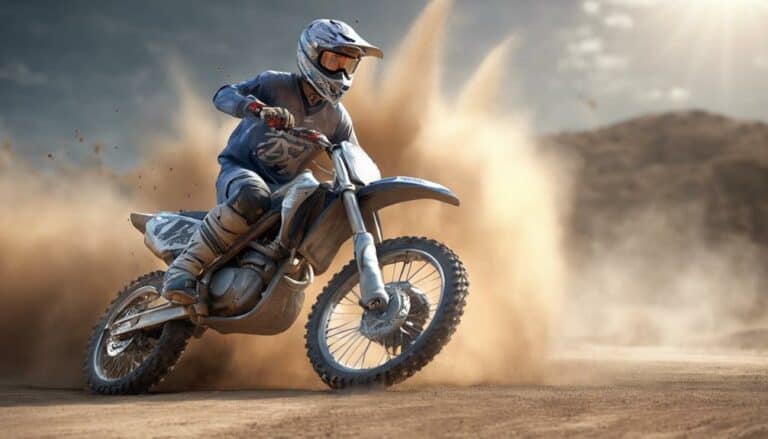Mastering proper braking techniques in dirt bike riding is not just helpful; it's absolutely critical for your safety and performance on the trails. Without a firm grasp on braking skills, your ability to navigate challenging terrains and tight turns can be severely compromised.
As you zip through rugged landscapes and unpredictable paths, your braking proficiency can be the determining factor between a thrilling ride and a potentially hazardous situation. Are you prepared to explore the intricate balance between caution and control when it comes to braking on your dirt bike?
Key Takeaways
- Proper braking is essential for control, safety, and precision in dirt bike riding.
- Front brake provides majority of braking force and aids in speed control and traction.
- Mastery of both front and rear brakes enhances overall riding proficiency.
- Effective braking techniques are crucial for safety, stability, and confidence on varied terrains.
Significance of Proper Braking
Mastering proper braking techniques is essential for maintaining control, safety, and precision in dirt bike riding. When entering a corner on a dirt bike, understanding the dynamics of the front wheel, front brake, braking force, and body position is vital.
The front brake is the primary source of stopping power on a dirt bike, providing about 80% of the braking force. To effectively navigate corners, apply gradual front brake pressure while maintaining a balanced body position to prevent the front wheel from locking up.
Proper use of the front brake before entering a corner allows you to control your speed, adjust your line, and maximize traction. By honing your front brake skills, you can confidently approach corners, reduce the risk of accidents, and improve your overall riding performance.
Types of Brakes for Dirt Bikes
Dirt bikes are commonly equipped with hydraulic disc brakes for both the front and rear wheels. The front brakes play an important role in providing around 70-80% of the total braking power on a dirt bike, emphasizing the significance of the front tire's grip and the rider's control over the brake lever. On the other hand, the rear brake aids in stabilizing the bike during braking and contributes additional stopping power. Hydraulic disc brakes are favored for their consistent performance across various riding conditions, offering riders the confidence needed to brake effectively before the corner. Mastering the skills required to modulate both front and rear brakes is essential for maximizing stopping power and tackling challenging terrains safely. Proper maintenance of these braking systems is paramount to ensure peak performance, highlighting the importance of understanding and honing braking techniques for dirt bike riders.
| Aspect | Description | Importance |
|---|---|---|
| Front Brakes | Provide majority of braking power; controlled via brake lever; critical for front tire grip | High |
| Rear Brakes | Aid in stability during braking; offer additional stopping power; require finesse in application | Moderate |
| Hydraulic Disc Brakes | Ensure consistent performance in varied conditions; boost rider confidence in braking | High |
Importance of Front and Rear Brakes
Proper utilization of the front and rear brakes on a dirt bike is paramount for maintaining control and ensuring safety while riding.
The front brake, contributing to 70-80% of the stopping power, plays an essential role in efficient braking. It allows for quicker stops, better speed control, and improved handling, particularly in challenging off-road terrains where traction is essential.
While the front brake dominates in stopping power, the rear brake is equally significant as it aids in balancing the bike during deceleration and turns. Effective speed modulation and traction management on dirt trails are achieved through a harmonious blend of front and rear brake usage.
Mastering the control of both brakes enhances overall riding proficiency, empowering you to maneuver confidently through various dirt riding scenarios. Remember, the front and rear brakes are your allies in maintaining speed, control, and traction, making them indispensable components for a safe and enjoyable dirt biking experience.
Techniques for Effective Braking
Utilizing both front and rear brakes effectively is essential for mastering control and precision in dirt bike riding techniques. When it comes to braking on dirt trails, here are some key techniques to keep in mind:
- Using the Front Brake: Practice using the front brake more than the rear to achieve quicker and more controlled stops.
- Entering the Corner: Brake before entering the corner while keeping the bike upright to maintain traction and control on loose terrain.
- Need for Practice: Regular practice of braking techniques is vital to develop muscle memory and improve your overall riding skills.
Safety Tips for Braking on Dirt Bikes
For best safety when braking on dirt bikes, mastering proper techniques and maintaining control are paramount.
When it comes to braking on dirt bikes, utilizing both front and rear brakes effectively is key to ensuring stability and control. Properly applying the front brake can greatly enhance traction and stability, especially when maneuvering turns.
Practice is essential to develop the necessary skills to balance braking and acceleration, particularly when cornering. By focusing on pre-corner braking and smoothly modulating the front brake, riders can improve their ability to handle various terrains with confidence.
Conclusion
To sum up, mastering proper braking techniques in dirt bike riding is essential for safety and performance.
Did you know that in a study of dirt bike accidents, it was found that 70% of crashes were caused by improper braking techniques?
By understanding the importance of front brake dominance, balancing caution, and practicing effective braking techniques, you can enhance your control, confidence, and overall riding experience on the trails.
Stay safe and keep practicing those braking skills!

